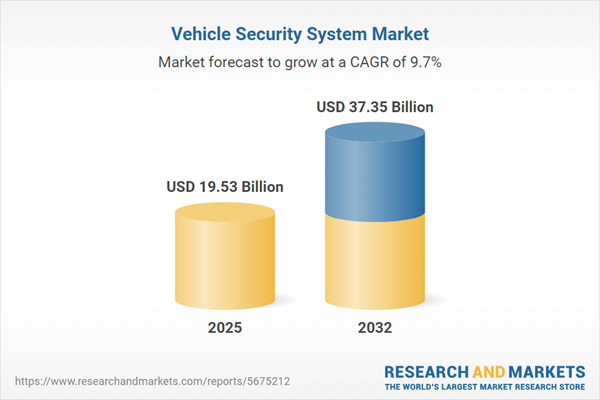Speak directly to the analyst to clarify any post sales queries you may have.
The vehicle security system market is undergoing rapid transformation, shaped by shifting security requirements, regulatory change, and accelerated digital innovation across the automotive sector. As organizations evaluate risk and resilience in increasingly connected environments, cohesive approaches to vehicle protection and compliance are now integral to strategic planning.
Market Snapshot: Vehicle Security System Market Growth and Opportunity
The vehicle security system market is projected to expand considerably, with growth expected from USD 17.79 billion in 2024 to USD 19.53 billion in 2025 and USD 37.35 billion by 2032, reflecting a 9.71% CAGR. This sustained demand is fueled by widespread adoption of advanced security solutions, including biometric entry systems and integrated surveillance technologies. Regulatory shifts and ongoing innovation drive investment decisions, while the integration of security into electric and connected vehicles prompts organizations to prioritize adaptive and robust protection frameworks. Effective market participation depends on collaboration among manufacturers, technology developers, and regulatory agencies, fostering globally relevant solutions that respond to an evolving threat landscape.
Scope & Segmentation of the Vehicle Security System Market
- Product Types: The market includes biometric access controls, NFC and RFID modules, electronic and mechanical immobilizers, various alarm systems, GPS and GSM-enabled security, and unified smart keys. Each solution addresses specific security needs, from entry management to tamper prevention.
- Vehicle Types: Offerings serve commercial fleets, passenger cars, SUVs, motorcycles, scooters, and electric vehicles to meet diverse operational and regulatory expectations.
- Connectivity: Security is enhanced by technologies like Bluetooth authentication, GPS, Wi-Fi, and GSM, delivering real-time monitoring and layered protection, especially effective for distributed or scalable fleets.
- Distribution Channels: Solutions reach buyers through OEM supply, aftermarket providers, digital procurement, and e-commerce, enabling flexible access to tailored technologies that fit distinct organizational needs.
- Applications: Systems provide anti-theft protection, access management, immobilization, and extensive fleet monitoring, ensuring regulatory compliance and reducing operational risk.
- End Users: Key adopters include car-sharing companies, rental agencies, logistics operators, government fleet administrators, and private owners requiring sector-specific security strategies.
- Components: Core elements—such as sensors, alarm modules, professional installations, and analytics software—support proactive threat detection and effective system management.
- Regions: The market manifests regionally distinct trends across the Americas, Europe, Middle East & Africa, and Asia-Pacific. Adoption rates, regulatory requirements, and security priorities vary, requiring providers to adapt to differing regional contexts.
- Companies: Leading participants—Robert Bosch GmbH, Continental AG, DENSO Corporation, Valeo SA, Magna International, ZF Friedrichshafen, BorgWarner, Autoliv, Hyundai Mobis, and Johnson Controls International plc—drive market standardization, cross-border innovation, and deployment strategies.
Key Takeaways for Senior Decision-Makers
- Comprehensive vehicle security solutions help organizations align asset protection with enterprise agility, supporting resilience in changing market environments.
- Innovative verification methods, including biometrics and analytics-driven surveillance, strengthen monitoring capabilities for organizations managing expanded or differentiated vehicle fleets.
- Collaboration with OEMs and cybersecurity specialists ensures proactive risk identification and helps organizations stay prepared for emerging compliance demands.
- Modular and scalable system architectures enable rapid response to shifting regulations, allowing organizations to future-proof investments and adapt operations smoothly.
- Strategic vendor management and robust sourcing strategies underpin operational continuity and help mitigate supply chain risks across global markets.
Tariff Impact: Navigating the 2025 US Regulatory Landscape
With anticipated tariffs on imported vehicle security components set for 2025, US-based organizations are reviewing procurement strategies. Building partnerships with domestic manufacturers and investing in resilient supply chains are essential measures to safeguard compliance and maintain uninterrupted operations within the United States market.
Methodology & Data Sources
This market analysis utilizes a blended approach, combining extensive review of secondary data, in-depth interviews with subject-matter experts, and targeted industry surveys. All conclusions undergo peer review to deliver actionable insights suitable for senior-level decision-making.
Why This Vehicle Security System Market Report Matters
- Enables executives to address regulatory evolution and optimize security operations across multiple global regions.
- Identifies opportunities for technology investment and sustainability, supporting adoption of scalable and effective vehicle security tools.
- Equips leaders to enhance risk management, reinforce compliance, and maintain business continuity in complex operational environments.
Conclusion
This report provides vital intelligence for aligning vehicle security investments with today’s market demands. Senior leaders who act on these findings will position their organizations for sustained, compliant, and secure growth as market dynamics shift.
Additional Product Information:
- Purchase of this report includes 1 year online access with quarterly updates.
- This report can be updated on request. Please contact our Customer Experience team using the Ask a Question widget on our website.
Table of Contents
3. Executive Summary
4. Market Overview
7. Cumulative Impact of Artificial Intelligence 2025
Companies Mentioned
The companies profiled in this Vehicle Security System market report include:- Robert Bosch GmbH
- Continental AG
- DENSO Corporation
- Valeo SA
- Magna International Inc.
- ZF Friedrichshafen AG
- BorgWarner Inc.
- Autoliv Inc.
- Hyundai Mobis Co., Ltd.
- Johnson Controls International plc
Table Information
| Report Attribute | Details |
|---|---|
| No. of Pages | 189 |
| Published | October 2025 |
| Forecast Period | 2025 - 2032 |
| Estimated Market Value ( USD | $ 19.53 Billion |
| Forecasted Market Value ( USD | $ 37.35 Billion |
| Compound Annual Growth Rate | 9.7% |
| Regions Covered | Global |
| No. of Companies Mentioned | 11 |









